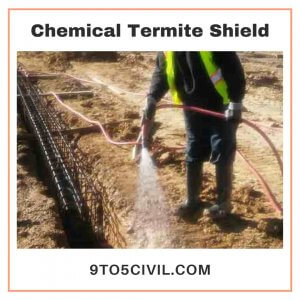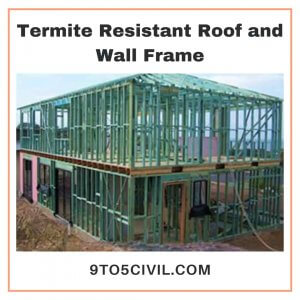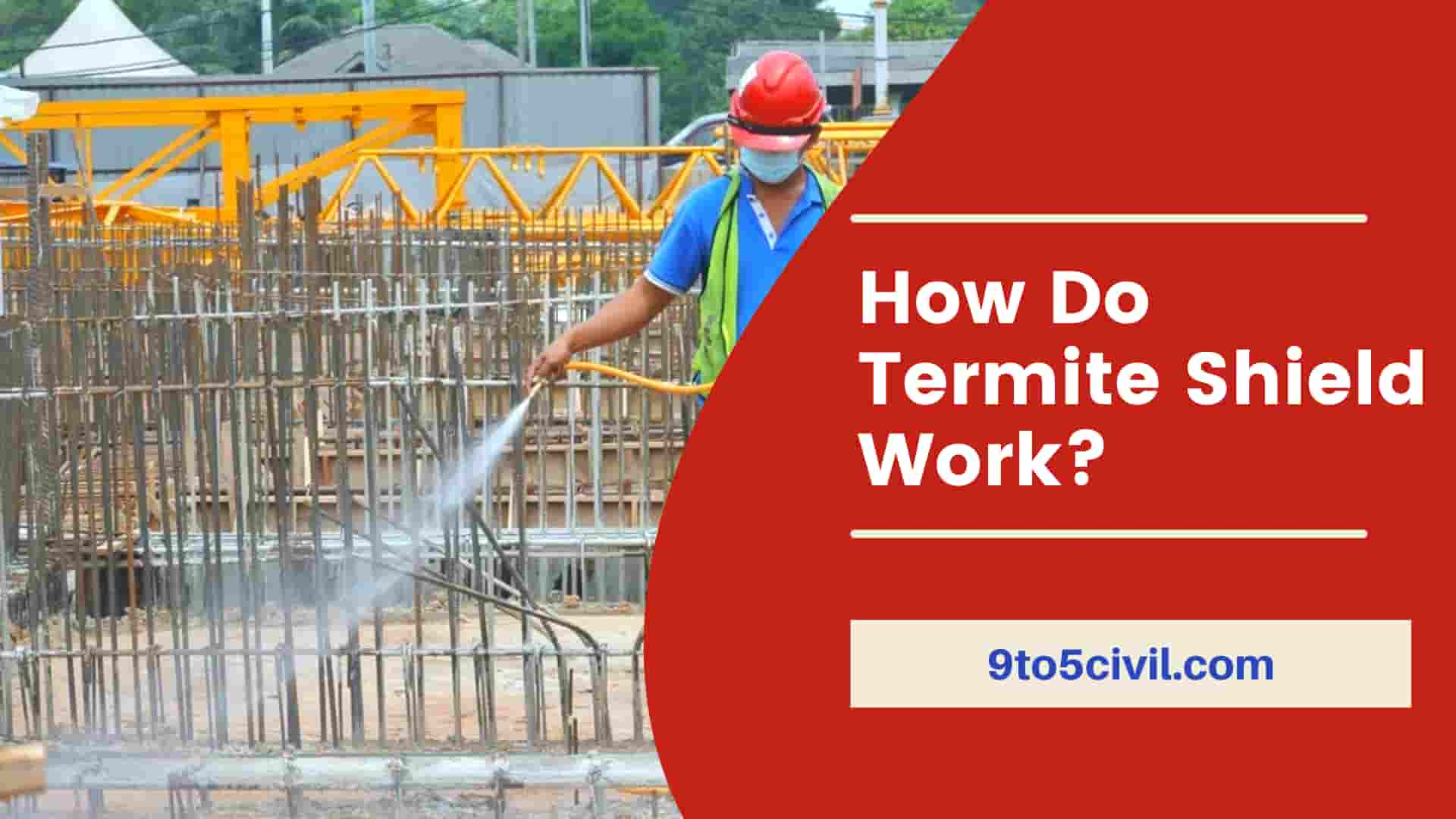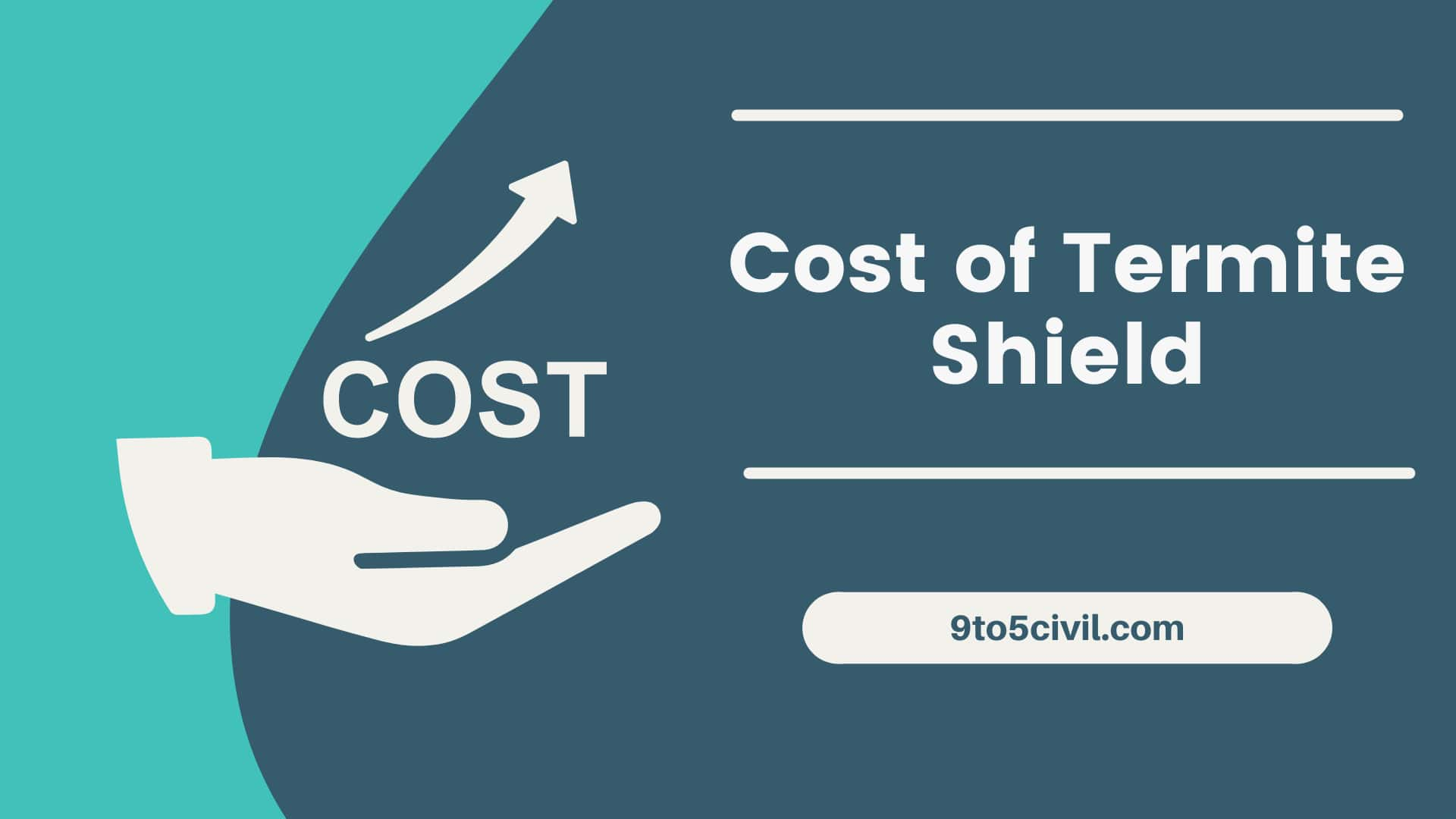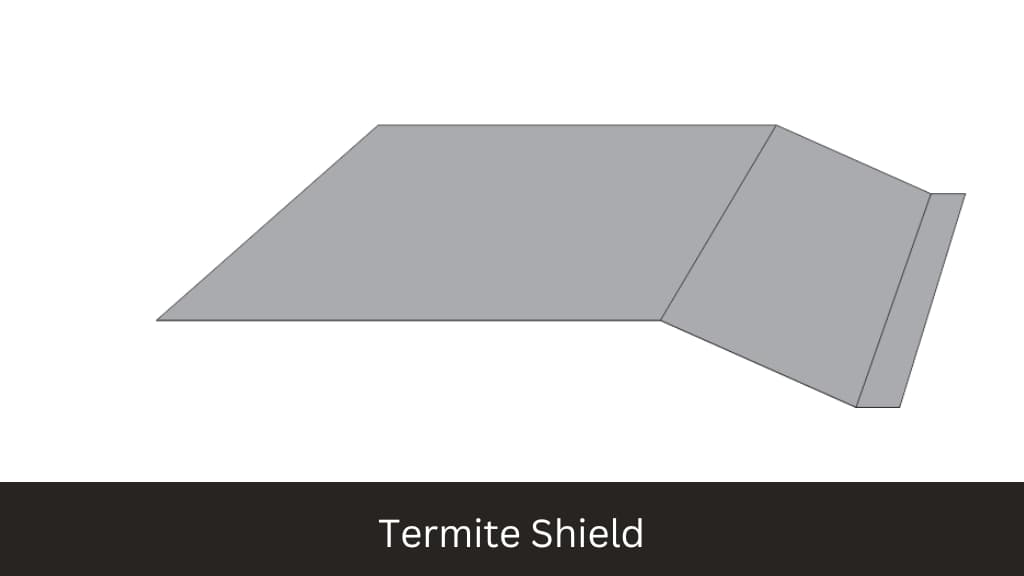
What Is a Termite Shield?
The Termite shield is made of 4-mils high-density polyethylene film. Which is a strong, flexible, self-adhesive sheet. Its total thickness is 68 mils.
The name termite shield is self-explanatory itself, it shields houses from termite invasion. It is a method to protect houses from termite infestations. It is installed to prevent termites to enter the areas which can easily be infested by them.
There are different types of shields. one of them is used to stop the subterranean termites from penetrating the wooden systems. Through this, the termites move the visible area of the house. it does not eradicate the termites but made it easy to see the movement of the termites. pest control staff can easily see where are the termites when they came for cleaning.
By using this method houses can be kept safe for a long time from termites. There are different types of termite barriers that work differently but give the same result. The result every person wants for their home is freedom from all the unwanted invasions in the house.
Termite shield solve one of those problems by preventing the entry of termites to the main source of their food that is cellulose parts and wooden frames.
Termite shields are one of the essential parts to choose when you want a house with a healthy environment. When you choose a house termite shields are a vital requirement.
Termite Shield Sill Plate
Termite barriers/shields are systems that keep termites out of your home by limiting entry points. It may also involve the use of products that prevent the existence of active termite colonies. You are advised to install termite barriers before construction or after the construction process is complete.
A termite shield is a sheet metal fabrication used in light frame construction to prevent termites from entering wood framing members such as joists and studs. However, many types of non-chemical termite deterrents are now used. Which is the origin of the termite shield.
Homeshield termite and pest control offer free inspections plus all-inclusive pricing in a variety of plans and services. YorkShield 106 TS™ provides a copper termite barrier. which is made from a sheet of 2 oz. Copper Termite Barrier is made of copper and a tough polymer layer, laminated with a 100% rubber adhesive.
Also Read: Lean To Roof Ideas | Sawtooth Roof | Hip and Valley Roof | Catslide Roof
Types of Termite Barrier
Termite shields are of three kinds, physical termite shield, Chemical termite shield, and roof and wall termite resistant frame. These three works differently but give the same result. That is prevention from termite penetration in the house. The types of termite shields are listed below with details:
1. Physical Termite Shield
Physical Termite Shield is a metal fabrication sheet that covers the slab frame of a house. It prevents the penetration of termites from the soil to the wooden frame or cellulose-containing frame.
It doesn’t eradicate the termite but forces them to move the exterior frames of the wall or floor. So, it becomes easier for the pest control staff to see them and eradicate them with the chemicals.
It is made of many different types of metals like galvanized steel, aluminum, terne, and copper. Use of these metals makes the sheets too hard to chew and penetrate. which made the termite migrate in open space, where it can be eradicated easily. It’s sustainable to the environment due to its nontoxic nature.
2. Termite Chemical Barrier
A Chemical Termite shield is a protection method that uses chemicals to get rid of termites. In it, chemicals are used in liquid form. The liquid chemical is applied in the soil or around the perimeter of your home or under the floor of concrete.
Its use can depend on how much area is affected by the termite. Or it can also use on the whole house without leaving any corner. In the latter condition, the house becomes termite resistant for more time.
It can be applied anytime, before construction or after construction doesn’t matter, unlike physical termite shield. This method is more useful for the eradication of Subterranean termites as it kills them. Which made their return in the wooden frames of the house difficult.
But before the whole process of chemical termite shield is completed, you have to check if there is any termite left alive. If there will even a small portion of termite left, they can come back again. And destroy the wooden frames. Which will lead to waste of all the effort you put on chemical termite shield.
Also Read : Conservatory Roof | Gable Roof | Bonnet Roof | Saltbox Roof | Gambrel Roof | Types of Curved Roof
3. Termite Resistant Roof and Wall Frame
The name Termite resistant roof and a wall frame explain itself what type of termite shield is this. In this type of termite shield, the roof and walls are installed with steel and timber. Steel and timber are naturally termite resistant.
So installation of this termite shield can naturally get rid of the termites. When the termites don’t get their food source which is cellulose-containing things, they leave the place. Termites don’t invasion a place where there are no cellulose-containing frames.
This method is not effective as a physical and chemical termite shield. Because the termites can feed on other cellulose materials other than walls and roofs. It is normal to give furniture in a house, which can be fed by the termites even if, there is termite resistant wall and roof are installed. So, it is not used by most people for termite eradication.
Also Read: Roof Flashing Types | Counter Flashing | Chimney Flashing | Best Flat Roof Coatings
How to Install Termite Shield?
A. Physical Termite Shield Installation
Steps for physical Termite shield installation:
1. Plan Installation Beforehand
First, prepare the subgrade, you have to check if it is level and compact.
The subgrade should be leveled for effectiveness. Then you have to check all the plumbing systems and utility systems. Work should be done without damaging the plumbing or utility system. And check if everything is placed in the right place. Then check the weather, as it also affects the installation process.
2. Covering the slab placement area.
In this step, you have to check if the slab is placed correctly or not. The slab should be placed properly otherwise it may affect the frame of the house.
3. Checking Seal of all the terminals
Then you have to check that all the terminals are sealed properly. So there will be no chance of termite penetration for a long time. It is one of the most important steps in the installation of a termite shield.
4. Sealing of slab penetration
Sealing the terminal of the slab and checking it properly. The terminal of the slab should be sealed properly for effectiveness in preventing termites.
5. Inspection and repairing work
Then you have to inspect the area properly to see if there is any corner which is not sealed properly. And if you find anything then start repairing it.
Also Read : What Is Roof Valley | What Is Metal Roof Insulation | Foam Gutter Guards | Modified Bitumen Roof
B. Chemical Termite Shield Installation
The first step in the installation of a chemical termite shield is to dig an area almost 300mm width and depth around the footing of the house. You have to take care of the measurement well and check all the area of the house is covered. Then the soil is injected with chemicals thoroughly. For this step, most of the time chemical is mixed with water.
There are two types of applying chemical barriers:
1. Drill and Inject
First, a hole in the concrete slab is made properly. And inject Termiticide into that hole. Then the hole has to be sealed properly. Make sure to check that the hole is perfectly sealed otherwise, the shape of the frame can get affected.
2. Cutting and Re-capping
Along the perimeter of the house, concrete is cut out. The chemicals are mixed with the soil. Then the re-capping is done. This method is useful for future use. In the future when you have to use a termite shield, you can just open the cap and use it.
Also Read: What Is Foundation Spalling? | Foundation Spalling Repair Cost
How Do Termite Shield Work?
A Termite shield protects your house by preventing entry of termites into it. It blocks the termites from penetrating the slab foundation or killing the termites. It works as a shield that protects your house from the invasion of termites. The working mechanic is different for different types of termite shields. The Termite Barrier Treatment is explained below:
Working of Physical Termite Shield:
In a physical termite shield, stainless steel mesh is used underneath the concrete slab. It prevents the termites to enter the interior frame of the house by blocking its path. So termites linger on the exterior surface of the framework of the house. Which makes them easy to detect and remove Unlike Chemical shields they don’t kill or repel termites. It blocks the termite’s path to enter the opening of the frames.
The particulate barrier is one of the physical termite shield methods. It comes up with a packed layer of basalt, soil, and granules. And because of the larger particles used with it, moving termites become difficult. Termites cant able to move because of the small space left between the granules.
Working of Chemical Termite Shield:
In this type of termite shield, a liquid chemical is used. Then the liquid chemical is injected into the soil underneath the slab. They do two things. First, they kill the termites, and second, they work as termite repellants.
When termites come in the contact with the chemical underneath the frame, chemicals start to kill termites. Transfer effect also there which means the termite which is exposed to chemical, it transfers the effect among its colony.
Also Read: Types of Drain Tile System | Interior Drain Tile | Exterior Drain Tile | Cost of Drain Tile System
Termite Barrier Cost
The cost of a termite shield depends on different things, and those are listed below:
1. Size of the area affected
The cost depends on the area affected by the termites. If the area is large then it cost more money than the area which is affected less. Because the materials used for the large area need more money
2. Type of Termite Shield
Types of termite shields also affect the cost. Physical termite shields come cheaper than chemical termite shields. Chemicals used for the eradication of termites are expensive.
3. Materials used
The material used in the making of the termite barrier also affects the cost. Like metal physical termite shields are cheaper than the granules physical termite shield. Using sand costs more money too. And using chemicals is by far more expensive.
4. Whether it is installed pre-construction or post-construction
Installation of termite shield charges differently on the based of whether it is pre-construction or post-construction. Pre-construction termite barriers are cheaper than post-construction termite barriers. Because pre-construction barriers are involved with the other constructional process.
That is easy for the workers. The cost of a termite shield is approximate$2000 to $3500. Though physical termite shields are cheaper than chemical termite shields. If only chemical repellant is used it will cost less than $500 than the above amount. But that is not good for the long term.
Also Read: What Is Permeation Grouting? | Uses of Permeation Grouting
Termite Barrier Products
There are various termite barrier products which are as follows
1. Graded Stone
Stones are used as termite barriers which helps in the destruction of termites in your house. It is a physical termite shield. One of the common termite barriers used is Granitgard graded stone. It works for a long time in preventing termites from entering the frames of the house.
2. Rentokil
It is a physical termite shield which is a protective single layer installed before pouring the concrete slab layer. It uses in pipes and the perimeter of the house. It prevents termites from entering the house.
3. Mesh
It is a physical termite shield made of stainless steel and installed underneath the concrete slab. It referred to the Termimesh system and it blocks the entry of termites underneath the slab. It is one of the methods used by most of the people in the world. And it is available everywhere in the whole world.
4. Spray
It is a chemical termite shield used as a hand spray or reticulation system. It doesn’t involve the injecting method rather it is used for spraying by hands. This kills and repels termites.
5. Plastic
Plastic is also used as a termite shield. It is an impregnating plastic sheet that contains chemicals, which kill and repels termites. It is installed underneath the concrete slab.
Advantages of Termite Barrier
Physical Termite Shield:
The advantages of the physical termite shield are as follows:
- There are many advantages in using a physical termite shield and those are it is cheaper than a chemical termite shield.
- As it does not use expensive chemicals, it is more budget-friendly for people who are looking for a termite shield.
- It is non-toxic which is very good for the sustainability of the environment. If you looking for an environment-friendly termite shield then it is the best choice.
- It Is effective for a long time if it is properly sealed during its installation.
- It saves a lot of money when the termite shield is used for long term
Chemical Termite Shield:
The various advantages of the chemical termite shield are as follows:
- A chemical termite shield is useful as it not only kills termites but it works as a termite repellant.
- So it is successfully eradicated termite infestation. It is one of the most effective termite barriers. And one of the best things about this is it does not require any structural alteration. Which is doesn’t cause any difficulty during the construction of the house.
Also Read:
Disadvantages of Termite Barrier:
Physical Termite Shield:
- The disadvantage of this method is that if the slab terminations don’t seal properly then termites can easily crawl inside the foundation slab. So you have to check properly if there is any space left.
- This method can be a hassle if it has been done post-construction
- Because you have to install a termite shield and with that, you have to lay the foundation slab again. And it can affect the shape of the house.
Chemical Termite Shield:
The disadvantages of Chemical Termite Shield are as follows:
- It is expensive in comparison to the physical barrier. Chemicals used in this method are really costly.
- So many people choose a physical termite shield over this to have a budget-friendly purchase.
- Its effectiveness is reduced by some climate changes and rain.
Also Read: What Is a Slate Roof? | Slate Roof Cost | Burnished Slate Metal Roof | Synthetic Slate Roofing
How to Maintain the Termite Prevention Features:
There are various ways to maintain the termite prevention features which are as follows:
- After the foundation construction, keep the soil around the foundation dry through proper grading and drainage which also includes the maintenance of gutters and downspouts.
- The Reduce openings that offer termites access to the structure by filling cracks that are present in cement foundations and the area around where utilities pass through the wall with cement.
- The leaks should be fixed as early as possible.
- The vents should be kept free from blockage, including plants.
- The care should be taken that trees and shrubs are not planted too close to the structure and do not allow them to grow against exposed wood surfaces.
- The pile of firewood or wood debris should not be stored next to the house.
- A periodic inspection should be done to help ensure that termite colonies do not become established.
Conclusion of Termite Shield:
Whenever inspecting a piece of the prospective real estate for the purchase it is very essential that you should confirm whether there the termite shield is installed or not. It is very essential that every homeowner should install a termite shield for their structures to prevent termite attacks.
Like this post? Share it with your friends!
Suggested Read –
- What Is Roof Valley? | Roof Valley Installation | Types of Roof Valleys | Repairing Roof Valleys
- French Casement Window | What Is French Casement Window? | Advantages & Disadvantagesof French Casement Windows
- What Is Composite Roofing? | Types of Composition Roofing | Composition Roof Cost
- What Is TPO Roofing? | TPO Roofing Installation & Cost | TPO Roof Repair
- Crawl Space Foundation | What Is Crawl Space Foundation? | How to Build a Crawl Space Foundation?
Termite Shield for Cinder Block
Termite cannot damage a foundation made of cinder block. However, Termite can enter the house through small cracks in its base. Termite usually enters the house through the crack of untreated hollow spaces in the Cinder Block.
What Is Termite Sheet?
Large sheets are used for physical termite barriers. Which are placed under or around the slab of your building or house. These sheets are protected from termites made of adhesive and cloth tape. The termite sheets are laid before the slab is poured. And pipes can also be placed around it.
What Are the Different Types of Termite Shields?
Termite shields are of three kinds, physical termite shield, Chemical termite shield, and roof and wall termite resistant frame.
How Does Termite Barrier Work?
A termite chemical barrier chemically encircles the perimeter of a building or structure with a treated zone. This treated zone disrupts the natural passage of the termite.
Are Termite Shields Necessary?
A termite shield is a requirement for home and building structures. It needs to be done as a preventive measure for foundations, home, and property structures.
How Thick Is a Termite Shield?
The Termite Barrier is made of 4-mils high-density polyethylene film. Which is a strong, flexible, self-adhesive sheet. Its total thickness is 68 mils.
How to Install Termite Shield Flashing
According to the traditional design, an effective termite shield is a metal termite shield. Which is projected at least 2 inches below the woodwork on each side of the foundation. The outer edge is held down at a 45-degree angle.
What Is the Purpose of a Termite Shield?
A termite shield is a metal termite shield. It is commonly used in the construction of light frames to reduce the movement of termite from clay to wood framing members such as floor joists and studs.
How Do You Seal a Foundation Termite Shield Plate?
Roll out the termite shield plate along the perimeter of the foundation wall. Place the sealing board back on top of the termite shield plate, seal sealer, and anchor bolt. Next, bolt it with washers and nuts.
What Can I Use for Termite Shield?
Termite shields are made of durable material. Which does not corrode. These include copper termite shield, metal termite shield, and copper termite shield plate.
 Skip to content
Skip to content 
